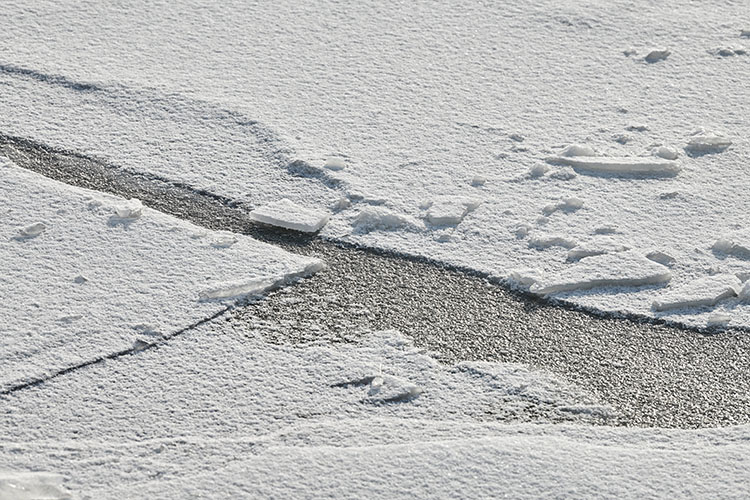January’s winter’s icy grip can wreak havoc on your concrete structures. Imagine waking up to a newly cracked driveway or a wonky patio – a common sight during and after winter. Concrete settling, often caused by frost heave and shifting soil, can be a significant headache.
Frost heave occurs when water in the ground freezes and expands, pushing upward on the concrete slab. Repeated freeze-thaw cycles can also weaken the soil beneath the concrete, leading to instability.
This article equips you with the knowledge and techniques to minimize settling and protect your concrete investments. You’re about to be an expert in all matters of settled concrete.
What Is Concrete Settling?
Concrete settling occurs when the soil beneath a concrete slab loses its ability to adequately support the weight of the concrete. This can happen due to various factors, such as changes in soil moisture content, erosion, or inadequate soil compaction during construction. As the soil shifts or compresses, it creates voids beneath the concrete, causing it to sink and potentially crack.
In simpler terms: Imagine a table sitting on a bed of sand. If the sand shifts or settles, the table legs will sink deeper into the sand, causing the table to become uneven. Similarly, settling concrete, when the soil beneath it changes, leading to instability and potential damage to the concrete structure.
Is concrete settling more common in winter?
Concrete settling can be more pronounced during winter due to several factors.
Firstly, frost heave is a significant contributor. As water in the ground freezes, it expands, exerting upward pressure on the concrete slab. This upward force can disrupt the soil beneath the concrete, leading to uneven settling and potential cracking.
Secondly, repeated freeze-thaw cycles can weaken the soil foundation. The constant expansion and contraction of the ground as it freezes and thaws can destabilize the soil, making it more susceptible to shifting and settling.
Finally, increased moisture during winter months can saturate the soil. This excess moisture can further weaken the soil’s ability to support the weight of the concrete, increasing the likelihood of settling.
While settling concrete can occur year-round, these winter-specific factors can exacerbate the issue and increase the risk of damage to concrete structures.
Other Factors That Cause Settled Concrete in Winter
In addition to frost heave, freeze-thaw cycles, and increased moisture, other factors can contribute to settling concrete during winter:
- Poor Soil Compaction: If the soil beneath the concrete was not properly compacted during construction, it can settle over time, especially when subjected to the stresses of winter weather.
- Inadequate Drainage: Poor drainage can lead to water pooling around the concrete, increasing soil saturation and the risk of settling.
- Tree Roots: Tree roots growing beneath the concrete can exert pressure on the slab, causing it to heave or settle.
- Heavy Snow Loads: In areas with heavy snowfall, the weight of accumulated snow can put additional stress on the concrete, potentially contributing to settling.
It’s important to note that these factors can interact with each other, exacerbating the risk of concrete settling. For example, poor drainage can lead to increased soil moisture, which can then be more susceptible to frost heave and freeze-thaw cycles.
The Best Ways to Prevent Concrete Settling in Winter
Homeowners can take several proactive steps to prevent concrete settling in winter:
1. Proper Drainage
Ensure proper drainage around the concrete to prevent water accumulation. This can involve installing gutters, downspouts, and grading the ground to direct water away from the concrete.
2. Soil Compaction
Proper soil compaction during construction is crucial to minimize settling. This involves compacting the soil beneath the concrete to ensure a stable foundation.
3. Frost Protection
In areas prone to frost heave, consider measures like insulating the ground beneath the concrete or using frost-resistant materials.
4. Professional Inspection
If you notice any signs of settling, such as cracks or uneven surfaces, consult with a concrete professional for an assessment and appropriate solutions.
5. Winter Maintenance
Regularly clear snow and ice from the concrete to prevent excessive weight and minimize the risk of damage. Avoid using de-icing salts, which can be corrosive to concrete.
By taking these preventative measures, homeowners can significantly reduce the risk of settling concrete and protect their investments from winter’s harsh effects.
Let’s talk now about getting your concrete ready for winter.
Preventing Settled Concrete: Getting Your Concrete Ready for Winter
Here are some things homeowners can do to get their concrete ready for winter:
1. Inspect and Repair Cracks
Carefully inspect concrete surfaces for cracks.
Small cracks can be filled with a high-quality concrete crack filler or sealant to prevent water infiltration, which can worsen during freeze-thaw cycles.
2. Seal Joints and Edges
Seal expansion joints and control joints with a flexible sealant to prevent water from entering and causing damage. Settled concrete? Never heard of it.
3. Improve Drainage
Ensure proper drainage around the concrete to prevent water accumulation.
Clean gutters and downspouts, and grade the ground to direct water away from the concrete.
4. Protect Exposed Edges
If applicable, consider applying a protective coating to exposed edges of the concrete to minimize the impact of de-icing salts.
By taking these steps, homeowners can help protect their concrete investments from the harsh effects of winter weather and ensure their longevity. For a more detailed explanation on how you can protect your concrete during winter we’ve also done a comprehensive guide here.
In Closing…
By implementing these preventative measures and staying vigilant for signs of settling, homeowners can significantly reduce the risk of damage to their concrete structures during the winter months. Proper drainage, regular inspections, and addressing issues promptly are key to ensuring the longevity and stability of your concrete.
For homeowners in Long Island, Queens, and the counties of Suffolk and Nassau, experiencing concrete settling issues, Mudjacking Contractor offer expert solutions. Their specialized techniques, such as mudjacking, effectively lift and stabilize sunken concrete, restoring its integrity and preventing further damage. With their expertise and commitment to customer satisfaction, Mudjacking Contractor are the ideal choice for all your concrete repair and maintenance needs.
Call us today or visit our website to learn more!

